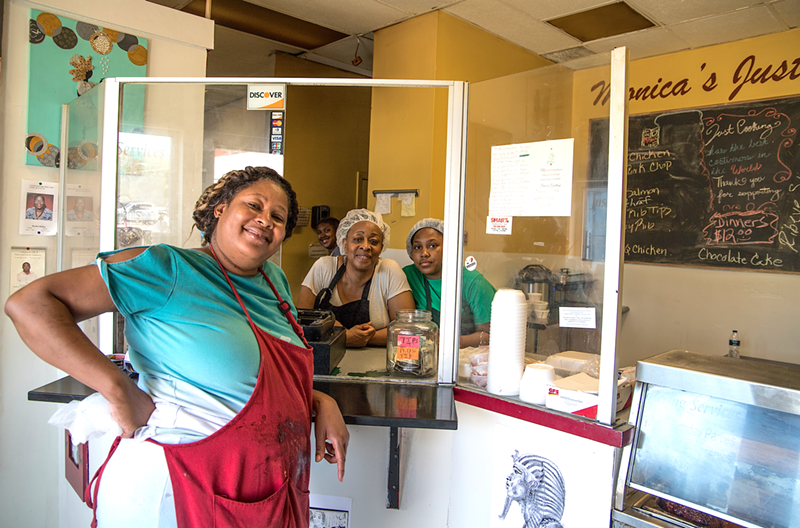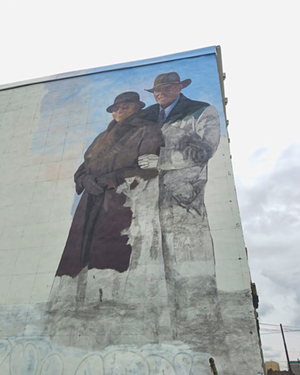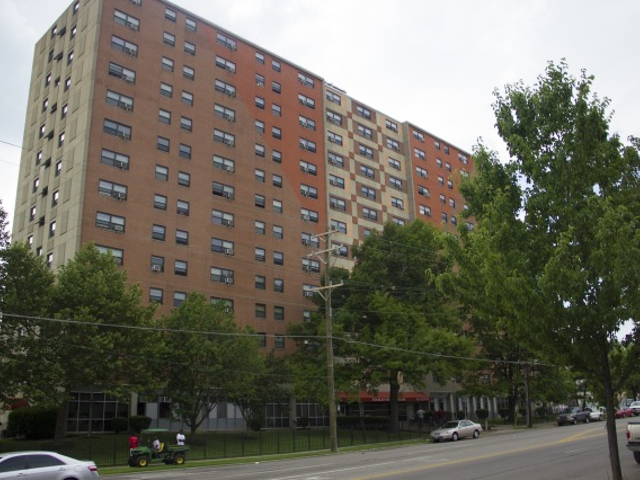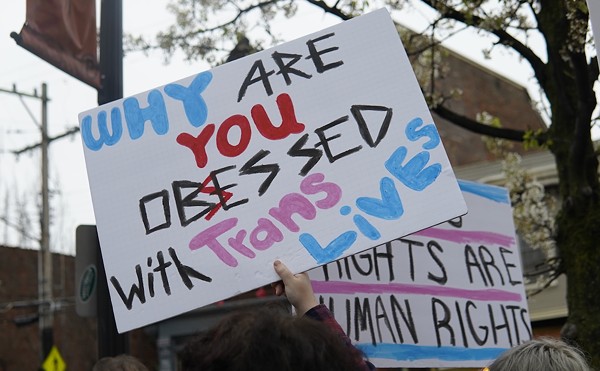On a stretch of Central Avenue just west of the hip, quickly-redeveloping enclave of Over-the-Rhine, there’s a dense half-block of Cincinnati's West End surrounded by a couple of vacant fields, Cincinnati Public School's School’s Stargel Stadium and some parking lots.
At the moment, it’s a microcosm of the predominantly African-American neighborhood’s past and present. It’s also a place where you can hear varying opinions about its uncertain future, which will see this block removed to make way for a new $250 million soccer stadium sometime next year.
On any given weekday, the spot where Central meets 15th Street hums with life. More than 100 people a day file through Just Cookin’ for Monica Williams' ribs, meatloaf, grilled salmon, greens, cornbread and any number of other hearty favorites depending on the day.
Around the corner, folks stream in and out of Community Barber Shop. There, Jason Briers cuts hair under the approving eyes of his father, present in the form of a black-and-white photo on the back wall. The elder Briers, who passed away a few years back, started the shop more than five decades ago. Next door, his other son, Jason's brother, tends a busy convenience store.
On Sundays, the pale blue and white building containing the barbershop and store — once the Beaux Arts-style State Theater — comes alive with the congregation of Lighthouse Ministries, led by Rev. Patrick Winkler.
Two residential buildings, both constructed around 1900 and currently vacant, round out the small outcropping of structures, which ends abruptly in a vacant lot that spans much of the rest of the block.
As a bookend, the last building sports a mural of West End magnates Fannie and William L. Mallory Sr. The mural isn’t quite finished — Mallory Sr., a prominent state lawmaker who passed way in 2013, is painted only down to the shoulders of his hunter green coat, and Fannie only to her knees. Below that, both are just ghostly outlines fading into thick-lined graffiti. A patch of blue sky crowns the Mallorys, the parents of one of Cincinnati’s most storied political dynasties, at the upper edge of the building.
Lately, their son, former Cincinnati mayor Mark Mallory, has been taking Just Cookin’s Williams around town to find a new spot for her restaurant. FC Cincinnati hired Mallory last year to do community engagement for their stadium plans, which became a certainty after the team was granted a Major League Soccer expansion franchise last month.
The day after one of those trips, Williams stands out in the afternoon sun to escape the brutal heat of her kitchen and says she remains hopeful that the coming change will be positive.
“Right now, I’m being optimistic and I’m hoping for the best for the community and for my business,” she says. “There’s a lot of potential there. We need change in the West End. If this change includes us, then it’s a good thing.”
Williams grew up in the neighborhood’s Lincoln Court, a Cincinnati Metropolitan Housing Authority project, but moved to Westwood after a program called Hope VI was launched in 1999 and resulted in the apartment complex’s removal. Years later, she returned to live in a townhouse in City West, the mixed-income development built as part of the Hope VI project.
Fueled by her love for the neighborhood, Williams started Just Cookin’ six years ago. At first, she did her favorites — lasagna, hot wings, salads. Those didn’t take off like she wanted them to, but the neighborhood spoke, and, as she says, designed the menu for her. Now the lines are out the door.
The interior of her take-out spot is a lot like Williams herself — warm, welcoming and at the same time, no-holds-barred. Pictures of Egyptian pharaohs share wall space with portraits of Muhammad Ali.
The south facing wall, to customers’ backs as they walk in, is the most intense in its honesty. A number of historical photos of Jim Crow-era lynchings hang here, along with obituaries of once-regular customers whose lives have been lost to neighborhood violence.
“This is reality,” Williams says as she points out the photos. “People need to see this. People on all sides need to see it.”
Not one to sugarcoat anything, Williams admits that many of her customers don’t yet share her optimism about the coming stadium.
“I see most of the same people every day,” she says. “A lot of them live in the neighborhood. Fear is what they feel. They’re scared, because the neighborhood is changing, and they don’t know if it’s changing for the better, or if it will exclude them out. They just want to know that they’ll have somewhere to live.”
That’s a big deal in a place where the median household income is around $15,000 a year and where 84 percent of the residents rent their homes. Rising housing prices in quickly redeveloping Over-the-Rhine next door, which has lost 72 percent of its most affordable housing units over the past decade, have stoked fears that something similar could happen here. Even before talk of a soccer stadium landed squarely in the neighborhood, there had been a wave of investment in real estate around the West End.
The neighborhood has roughly 1,200 units of housing locked into long-term affordability by virtue of their status as Cincinnati Metropolitan Housing Authority offerings or because developers used government funding like Low Income Housing Tax Credits to build them. But Census data suggests at least 3,000 people in the neighborhood — roughly half of its population — need sub-market rate housing.
As part of a community benefits agreement signed between West End Community Council representatives and FC Cincinnati, the Greater Cincinnati Redevelopment Authority will perform a housing inventory of the neighborhood to determine what kind of housing to build on some 60 parcels of land west of the stadium site left unused after the Hope VI project.
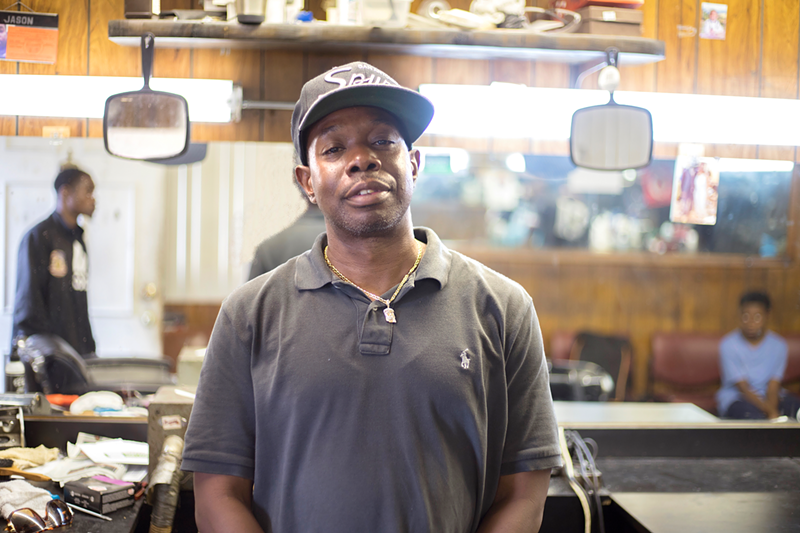
Briers of the Community Barber Shop identifies with those worried about the neighborhood’s future. He has watched the various dominoes — sale of Cincinnati Public School land for the stadium earlier this year, the political wrangling around the neighborhood's community council, city council's $34 million deal to provide infrastructure for the coming facility — fall and bring the stadium closer to reality.
“I don’t want to leave,” he says. “My clientele is here. I don’t understand how they did us like this. CPS, West End council, city council, I don’t know why they did this.”
Briers’ small, rectangular shop is lined floor to ceiling with warm wood paneling and silvery mirrors. For the 49-year-old, leaving it will be deeply personal and difficult.
“I have an apartment upstairs,” he says. “I’m losing a place to live and a place for business. I’m being displaced.”
The spot is close to most of the people who have been coming into the shop for years, Briers says, and within walking distance to Chatfield College, where he is taking business courses.
Briers’ father started the barbershop here in the 1960s, when this strip of Central Avenue was bustling. At that time, the State Theater, built in 1915, was still operating, drawing a steady stream of people coming to watch the shows. Restaurants and stores lined the streets.
Time, along with economic and racial isolation, changed the area. Jobs at nearby industries became harder to find and lower-paying. Lack of investment toppled buildings. The State Theater, next to the barbershop, closed in 1989.
But Briers’ father — and then Briers and his brother — stayed, providing a vital place for connections and community.
“It’s like home here,” Briers says. “We talk about all the topics in the world: sports, news, everything. Some people can’t talk to other folks at home, but they come here and can’t shut up. Kids come here and learn a lot. This is their spot.”
The shop has a number of regulars, including William Mallory Jr., a municipal court judge, and other members of the Mallory family who haven’t been as amenable to the stadium as their brother Mark has been.
Both Joe Mallory, a vice president of Cincinnati’s NAACP chapter, and Dale Mallory, a state lawmaker, appeared at protests against the stadium this spring. The latter invoked his father in remarks about the demolition of Stargel Stadium, named for prominent West End athlete and coach William Stargel.
“They're destroying our history,” he said. “And that's one thing my father told me, 'Do not let anybody destroy your history.’ ”
Former mayor Mallory says FC Cincinnati is sensitive to the challenges relocating will cause.
“From our standpoint, we want this to be a net positive,” he says. “We don’t want to come into the community and cause a disruption for the people who have been there. We’ve gone around and have looked at some spaces that may or may not work. That process continues. I’ve been looking at several spaces for the barber shop and the convenience store.”
Mallory says the timeline for those relocations is uncertain, but that he’d like to find new places for all the businesses in the area as soon as possible. Williams and Briers believe they will need to be out by December at the latest.
There are still questions to be answered. Hamilton County auditor records show Winkler hasn’t sold his building yet. Much of the other land needed for the stadium, including the vacant plots under the steady gaze of the larger-than-life, but unfinished, mural of Fannie and William L. Mallory Sr., aren’t yet owned by FC Cincinnati either.
Briers sits in a barber’s chair as a few folks wander into the shop early one recent morning. He sounds resigned about his impending move, but upset.
“The thing is, I can’t say anything about my landlord,” he says of Lighthouse Church’s Rev. Winkler, who owns the building. “He’s working with me, making sure I find something. We’ve looked at other spots. He’s a good man. Right now, I’m just going on what they say they’re going to do. I can’t see the future.”

